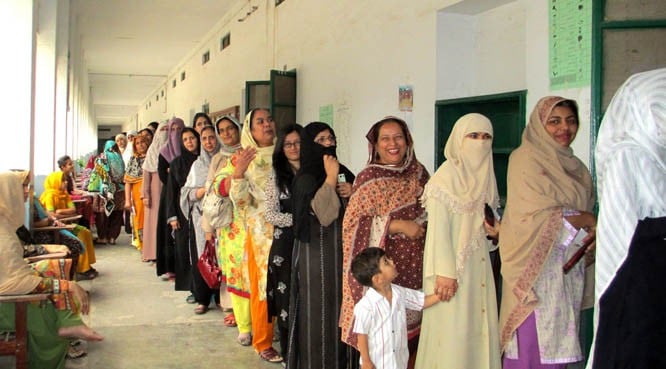
Pakistani women are creating history in struggle for parliamentary democracy

If politics is about empowerment, Pakistani women despite many barriers continue to create surprising history. Brave and bold women leaders, including Fatima Jinnah, Nusrat Bhutto, Benazir Bhutto and Kulsoom Nawaz, put historic resistance against dictators. Amongst them Benazir Bhutto became the first democratically-elected prime minister of Pakistan and the first to lead a country in the Islamic world.
While these iconic women had to author their own chapters of history in relentless struggle, the overall political landscape tells a tougher tale. If we make only the Election 2018 a reference point for analysis it was pleasant to see a poster of Raza Rabbani Khar, MNA from NA 183, who proudly put a picture of his illustrious sister, Hina Rabbani Khar, on his election poster. This is a significant departure as many women candidates in Pakistani polity had to print the pictures of their father, brother or husband.
The Election 2018 were unique in the sense that for the first time the Election Act, 2017 made it mandatory for the political parties to award five per cent tickets to women candidates. Majority of the political parties adhered to it. The non-complying were issued ‘show cause’ notices. Similarly, it was made clear that if the women vote in any constituency will be less than 10 per cent of the overall polled votes, then the election in that constituency will be declared null and void.
We saw for first time by-elections happening in a provincial assembly constituency in Khyber Pakhtunkhwa. These are significant steps. These provisions of the law were enforced for the first time and out of the four permanent provincial members of the Election Commission of Pakistan one from Khyber Pakhtunkhwa was woman who played an instrumental role in the changing culture of otherwise male-dominated election body.
Out of 192 countries in the world, according to Global population statistics, there are 81 countries in which women are in majority and in 36 countries women are in minority that is men are in majority and in 75 countries both men and women are in equal number. The global average of women population is 49.55 per cent.
According to the Census 2017 in Pakistan women population is 48.76 per cent, which is 0.79 per cent less than the global women population that is almost close to an overall global average.
However, in political arena the statistics tell a different story. According to Election Commission of Pakistan in 2018 the total number of registered voters was 105 million with male voters being 59.2 million, which is 55.74 per cent and female voters being 46.7 million that is 46.72 per cent. There was a gap of 9 per cent between male and female voters. However, out of total 53.1 million votes cast 33.0 million male and 21.8 million female cast votes.
Another interesting comparison will be the gender gap between rural urban populations. As per census 2017 the overall male population is 51.23 per cent and female is 48.76 per cent. But in urban areas male population is 52 per cent whereas urban female population is 48 per cent creating a gender gap of 4 per cent. Similarly, the male rural population is 51 per cent and female rural population is 49 per cent with a gender gap of 2 per cent. This means the gender gap in urban areas is more than the gender gap in rural areas.
Interestingly, the highest women voter turnout both nationally and provincially was in rural and semi-urban constituencies. And all the eight women who won direct constituencies hail from rural sociology. The unique one is the first women speaker of the National Assembly of Pakistan, Dr Fehmida Mirza, who has won her constituency in Badin (Sindh) for the fifth consecutive term since 1997. The other lucky women members of the National Assembly include Dr. Nafeesa Shah (Khairpur), Shamsunnisa (Thatta), Shazia Marri (Sangar), Zubaida Jalal (Turbat), Zertaj Gul (Dera Ghazi Khan), Mehnaz Akber (Shakargarh), and Ghulam Bibi (Jhang). Can we draw an inference that rural sociology is more accommodative politically for women?
The less told story of the Senate elections in March 2018 is equally impressive. We had the first woman leader of opposition -- Senator Sherry Rehman. It was a short-lived situation and now she is the parliamentary leader of her party. Similarly, a woman from minorities Karishna Kohli was elected on a women seat and another woman Engineer Rukhsana Zubairi was elected on a technocrat seat.
According to the data collected by the Inter Parliamentary Union, the global parliamentary population is 46,083. Out of this 11,037 or 24 per cent are women. In Pakistan, although we have 60 reserved seats for women in the National Assembly of Pakistan, we have 69 women members. Eight are directly elected and one woman claimed equality on seats reserved for religious minorities. Women presence becomes 20.17 per cent in the 342-member house. Similarly, in the Senate of Pakistan we have 17 seats reserved for women but currently there are 20 (19.23 per cent) women in the 104-member house. These figures are impressive and improving.